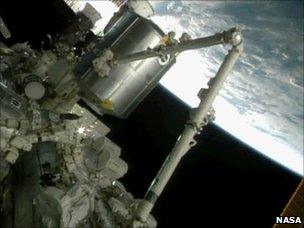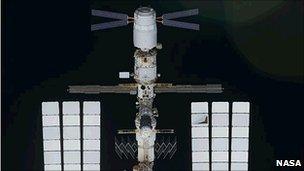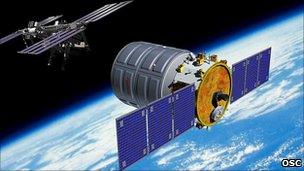Space station gets new store room
- Published

The eighth and final trip up - Leonardo is now to be left at the International Space Station
The last of Europe's permanent modules has been attached to the International Space Station (ISS).
Astronauts used the platform's robotic arm on Tuesday to lift the Leonardo cylinder out of the Discovery shuttle's payload bay and berth it to the underside of the 350km-high lab.
Leonardo will be used as extra storage space on the ISS.
Originally built to transport cargo to and from the station inside shuttles, the module is now being left in orbit.
This has required making some modifications to the module, the most important being the addition of extra shielding to protect it against small meteoritic impacts.
The journey up with Discovery was its eighth trip to the ISS. First flown in 2001, also on Discovery, the module was one of three so-called Multipurpose Logistics Modules built under an agreement between the Italian space agency (Asi) and the US space agency (Nasa).
In return for providing the MPLMs, Asi was given seats on shuttle flights for its astronauts. The next individual to benefit from the arrangement will be Roberto Vittori, who will fly to the ISS in April when the shuttle Endeavour undertakes its final mission.
Leonardo was built in Turin by Thales Alenia Space. The company has now provided over half of the pressurised volume, external on the US side of the station. This includes the cargo vessel on the recently attached Johannes Kepler space freighter; the connecting Nodes 2 and 3; the main structure of Europe's Columbus laboratory; and the Cupola observation deck.
"People in Italy and the rest of Europe may not realise how much of the space station was built in Turin," said Luigi Quaglino, senior vice president of space infrastructures and transportation at TAS.
"I think it's better known in the States because when we go to Nasa we have a lot of a appreciation for what we did. And I have to say, it was not a surprise when we signed the contract for Cygnus," he told BBC News.
Cygnus is the next big project for TAS at the space station. It is a robotic cargo ship being developed in partnership with the American Orbital Sciences Corporation.

The Johannes Kepler freighter was pictured on the end of the ISS by the approaching Discovery shuttle
TAS is making the pressurised container on the front of the ship that will hold the supplies being taken up to the ISS; Orbital is making the propulsion and control unit on the rear, and the rocket that will blast Cygnus into orbit.
The first Cygnus should fly before the end of the year.
Leonardo's instalment means just one more permanent European piece of hardware awaits delivery to the ISS. This is the European Robotic Arm, which will be carried into orbit on a Russian Proton rocket, together with a Russian laboratory, in May 2012.
Thales Alenia also has inflatable module technology it would like to send to the ISS and is in discussion with the various space agencies to see if there might be an opportunity to get a model in orbit this decade.

Cygnus is a new cargo ship
"Today, all we can say is that we continue to do some studies and development activity, but there is not yet a decision," said Mr Quaglino.
"This is not excluded because we are still talking with the Italian space agency and we try also to have an agreement with Esa or with Nasa directly to have a mission. So, it's something we keep working on but a real mission has yet to be fixed. It's an important technology for the future but the exploration programme has to be defined, and like everyone we are waiting for that to happen."
Shuttle Discovery is now half-way through its final mission. Once the shuttle returns to Earth next Monday, it will be prepared for museum display. Nasa plans only two more orbiter flights - Endeavour's mission and a final outing for Atlantis.
- Published28 February 2011
- Published24 February 2011
- Published24 February 2011